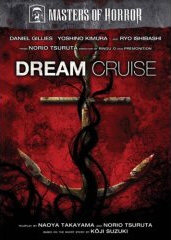
Revitalizing the nature of the genre with unique interpretations of the supernatural intimately connected with the seemingly concrete existence of the everyday, Asian horror brought a new level of thematic maturity, emotional depth, and intellectual resonance to the horror film. Finding new ways to express timeless motifs, Japanese thrillers like Ringu and Ju-On encouraged audiences to see threats both physical and psychical, depicting the nightmarish and abhorrent as both terrifying and strangely beautiful. Enacting cosmic tragedies against symbols of supernatural fear and internal responsibility, these films question Man's perception of himself and the possibly illusory nature of existence, illuminating the spiritual Otherworld with a sensibility soaked in the horrific heritage of folklore. Dream Cruise, the newest entry in Season Two of Masters of Horror, achieve this symbiosis of the supernatural and psychological with intelligence and style. A piece of subversive poetry, this modern ghost story is as much about redemption as scares.
Investing the traditional storytelling themes of a love triangle and addled lover with supernatural intensity, Dream Cruise was adapted to the small screen by Naoya Takayama and Norio Tsuruta from an original short story by Koji Suzuki. Making intimate universally felt fears and distrusts, the plot invites viewers to empathize with characters while examining their own reactions to similar matters of lust, love, and death.
Daniel Gillies is Jack, an American lawyer pursuing his fast track career in Japan. Jack is tortured by a re-occurring nightmare; when he was younger he allowed his younger brother to drown after their boat capsized. Of course now he is terrified of water. When a client who Jack needs to sign some papers suspects him of sleeping with his wife and invites him on an afternoon cruise, he has to accept. Things get more interesting when we discover that the client's last wife disappeared under mysterious circumstances out at sea. Soon not one but two spirits are haunting the high seas, along with a drunk angry husband. And we see the truth in the old saying that the past comes back to haunt you. Indeed.
Perhaps the finest aesthetic achievement of Dream Cruise is the balance attained between graphic horror and moody subtlety. Finding terror in suggestion, lighting, and an unearthly atmosphere sustained throughout the experience, what could have been simply another revenge tale is given shades of originality and psychological intensity. Dream Cruise walks a tight line between graphic explicitness and suggestive nightmare. Combining the tensions of alienation with liberation, an Outsider living with shame and insecurity experiences a horrible freedom, of sorts, by indulging unconsciously in a forbidden sexuality. This reinterpretation of a classic tragic trope is an emotionally painful examination of unreasoning superstition, prejudice, and culpability -- so very effective because its kiss of wormwood is as deadly as it is seductive. In a plot that interweaves classical tragic themes and romance with the understated supernatural, this modern folk tale of love, loss, and decadence is an unnerving take on the classic mythical themes that never forgets its modern audience. If we've seen all of the visual shocks before, including such worn tropes as long haired spectral wraiths and vengeful husbands, they are lent a satisfying intensity. And while Norio Tsuruta has never attained the popularity of Hideo Nakata, he shows himself in able form in this contribution to the MOH franchise.
Dream Cruise is presented in anamorphic 1.78.1 widescreen. Images are sharp, crisp, and clean. Color is bright and satisfying. No grain or weak spots are apparent. Audio is available in both Dolby Digital 5.1 Surround Sound and Dolby Digital 2.0 Stereo. The former does an especially commendable job mixing the sounds, differentiating between effects and score in an unsettling and often explosive manner.
Extras are as exhaustive as any other disc from this series. First we have the Audio Commentary featuring Daniel Gillies and producer Mick Garris. Both folks are enthusiastic and friendly, and listening to them expound on the shoot and each other gives one the feeling of listening to a rather good conversation in a pub. The 'Making of Featurette' features a worthwhile attempt at dissecting the differences between Western and Japanese horror films while exploring chief FX work and highlighting cast and crew in action. Last is a Still Gallery, Trailers, and the script in PDF for the DVD-ROM.
Review by William P. Simmons
| Released by Starz/Anchor Bay |
| Region 1 - NTSC |
| Not Rated |
| Extras : |
| see main review |